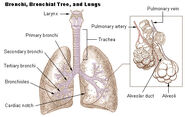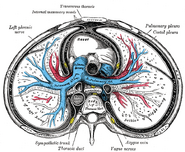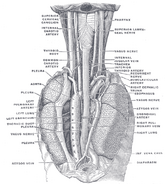Assessment |
Biopsychology |
Comparative |
Cognitive |
Developmental |
Language |
Individual differences |
Personality |
Philosophy |
Social |
Methods |
Statistics |
Clinical |
Educational |
Industrial |
Professional items |
World psychology |
Biological: Behavioural genetics · Evolutionary psychology · Neuroanatomy · Neurochemistry · Neuroendocrinology · Neuroscience · Psychoneuroimmunology · Physiological Psychology · Psychopharmacology (Index, Outline)
| Artery: Pulmonary artery | ||
|---|---|---|
| [[Image:{{{Image}}}|250px|center|]] | ||
| Anterior (frontal) view of the opened heart. White arrows indicate normal blood flow. (Pulmonary artery labeled at upper right.) | ||
| [[Image:{{{Image2}}}|250px|center|]] | ||
| {{{Caption2}}} | ||
| Latin | truncus pulmonalis, arteria pulmonalis | |
| Gray's | subject #141 543 | |
| Supplies | ||
| From | right ventricle | |
| To | ||
| Vein | {{{Vein}}} | |
| MeSH | A07.231.114.715 | |
| Dorlands/Elsevier | t_20/12826098 | |
The pulmonary artery carries deoxygenated blood from the heart to the lungs. It is one of the only arteries (other than the umbilical arteries in the fetus) that carry deoxygenated blood.
Structure[]
In the human heart, the pulmonary trunk ('pulmonary artery or main pulmonary artery) begins at the base of the right ventricle. It is short and wide—approximately Template:Convert/cmTemplate:Convert/test/A in length and Template:Convert/cmTemplate:Convert/test/A in diameter. It then branches into two pulmonary arteries (left and right), which deliver deoxygenated blood to the corresponding lung. [citation needed]
Embryology[]
Template:Expand section
Function[]
The pulmonary artery carries deoxygenated blood from the right ventricle to the lungs. The blood here passes through capillaries adjacent to alveoli and becomes oxygenated as part of the process of respiration. [citation needed]
In contrast to the pulmonary arteries, the bronchial arteries supply nutrition to the lungs themselves. [citation needed]
Pulmonary artery pressure[]
The pulmonary artery pressure is a measure of the blood pressure found in the pulmonary artery. This is measured by inserting a catheter into the pulmonary artery.[1] :190-191 The mean pressure is typically 9 - 18 mmHg.,[2] and the wedge pressure measured in the left atrium may be 6-12mmHg. The wedge pressure may be elevated in left heart failure [1]:190-191 and other conditions, such as sickle cell disease.[3]
Clinical significance[]
The pulmonary artery is relevant in a number of clinical states. Pulmonary hypertension is used to describe an increase in the pressure of the pulmonary artery, and may be defined as a mean pulmonary artery pressure of greater than 25mmHg.[1]:720 This may occur as a result of heart problems such as heart failure, lung or airway disease such as COPD or scleroderma, or thromboembolic disease such as pulmonary embolism or emboli seen in sickle cell anaemia.[1]:720-721
Pulmonary embolism refers to an emboli that lodges in the pulmonary circulation. This may arise from a deep venous thrombosis, especially after a period of immobility. A pulmonary embolus is a common cause of death in patients with cancer and stroke.[1]:720-721 A large pulmonary embolus affecting the pulmonary trunk is called a saddle embolus. [citation needed]
Additional images[]
| Dissection images |
|---|
Fetal pulmonary artery Pulmonary artery Pulmonary trunk Pulmonary artery Pulmonary artery Pulmonary trunk Pulmonary artery Pulmonary artery |
See also[]
- Chronic obstructive lung disease
- Pulmonary hypertension
- Thromboembolic disease
- Pulmonary circulation
- Rasmussen's aneurysm
External links[]
- GPnotebook 53805116
- Dictionary at eMedicine pulmonary+trunk
- SUNY Labs 20:01-0106 - "Heart: The Pericardial sac and Great vessels"
- SUNY Labs 20:07-0105 - "Heart: Openings of Great Vessels into the Pericardial Sac"
- SUNY Figs 19:05-06 - "Mediastinal surface of the right lung."
- SUNY Figs 19:06-02 - "Mediastinal surface of the left lung."
- Histology at Boston University 13802loa
References[]
- ↑ 1.0 1.1 1.2 1.3 1.4 (2010) Davidson's principles and practice of medicine., 21st ed., Edinburgh: Churchill Livingstone/Elsevier.
- ↑ Edwards Lifesciences LLC > Normal Hemodynamic Parameters – Adult 2009
- ↑ Pashankar FD, Carbonella J, Bazzy-Asaad A, Friedman A (April 2008). Prevalence and risk factors of elevated pulmonary artery pressures in children with sickle cell disease. Pediatrics 121 (4): 777–82.
Cardiovascular system |
|---|
|
Blood | Heart → Aorta → Arteries → Arterioles → Capillaries → Venules → Veins → Vena cava → Heart → Pulmonary arteries → Lungs → Pulmonary vein |
Template:Arteries of chest
| This page uses Creative Commons Licensed content from Wikipedia (view authors). |


